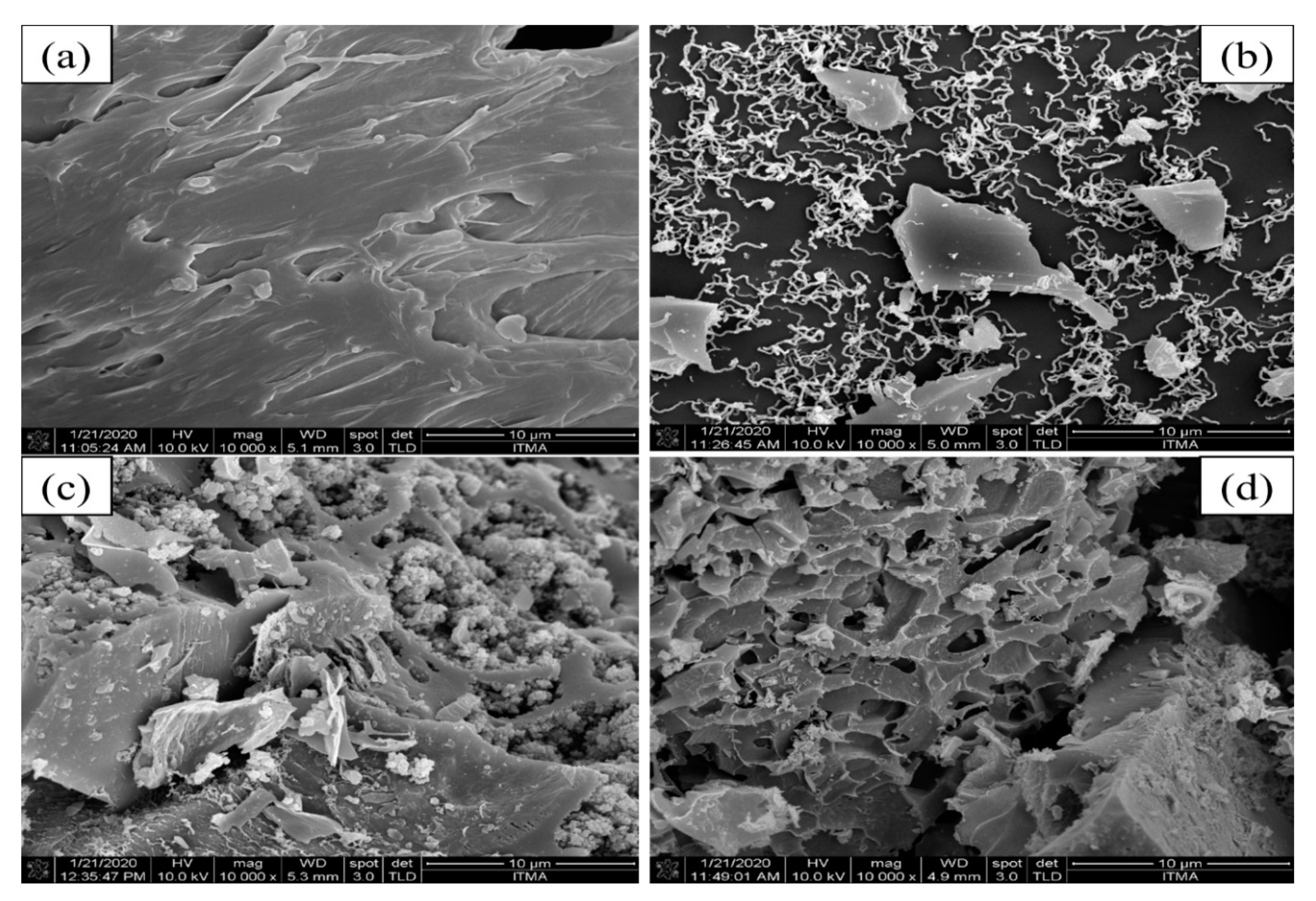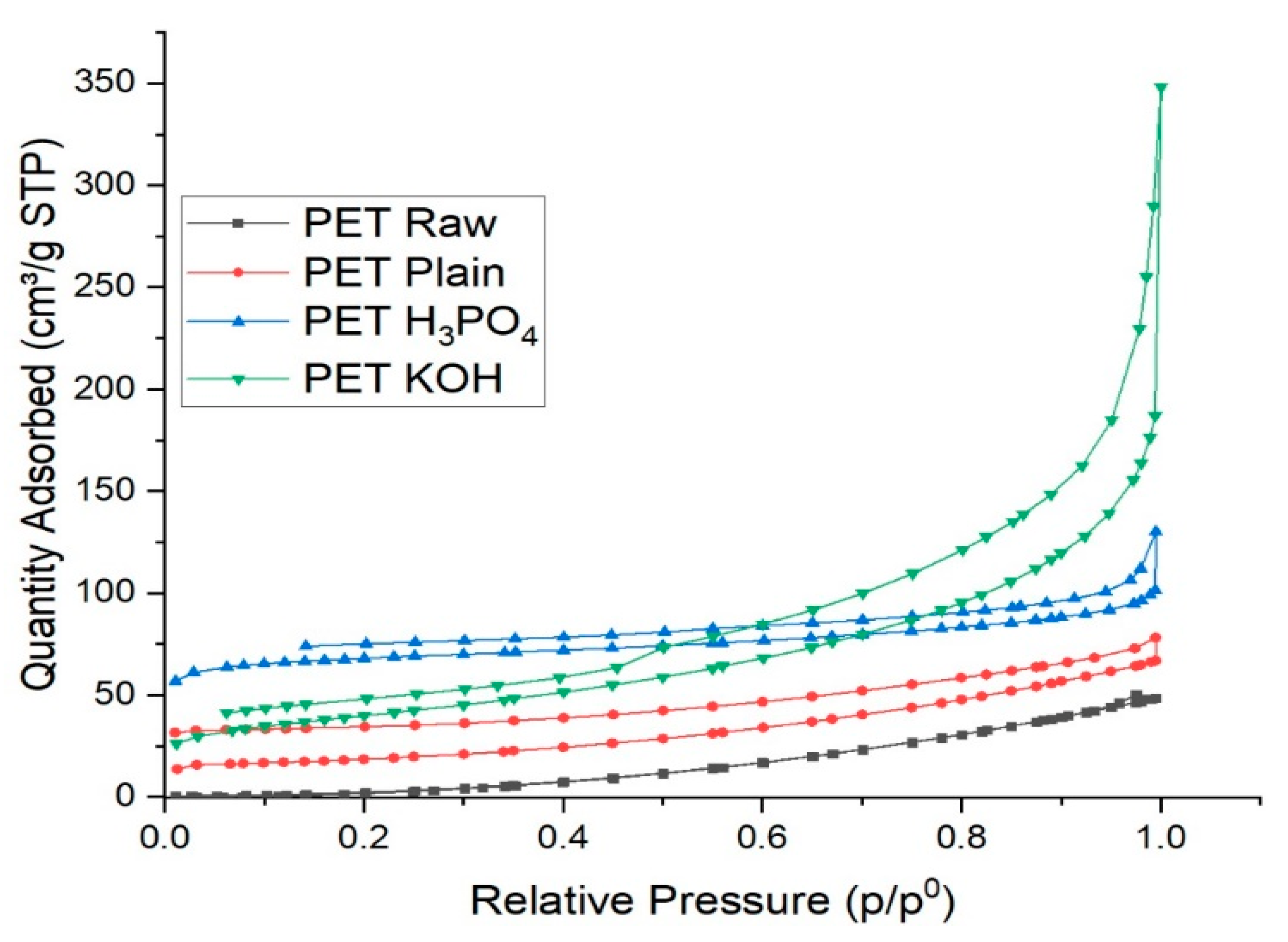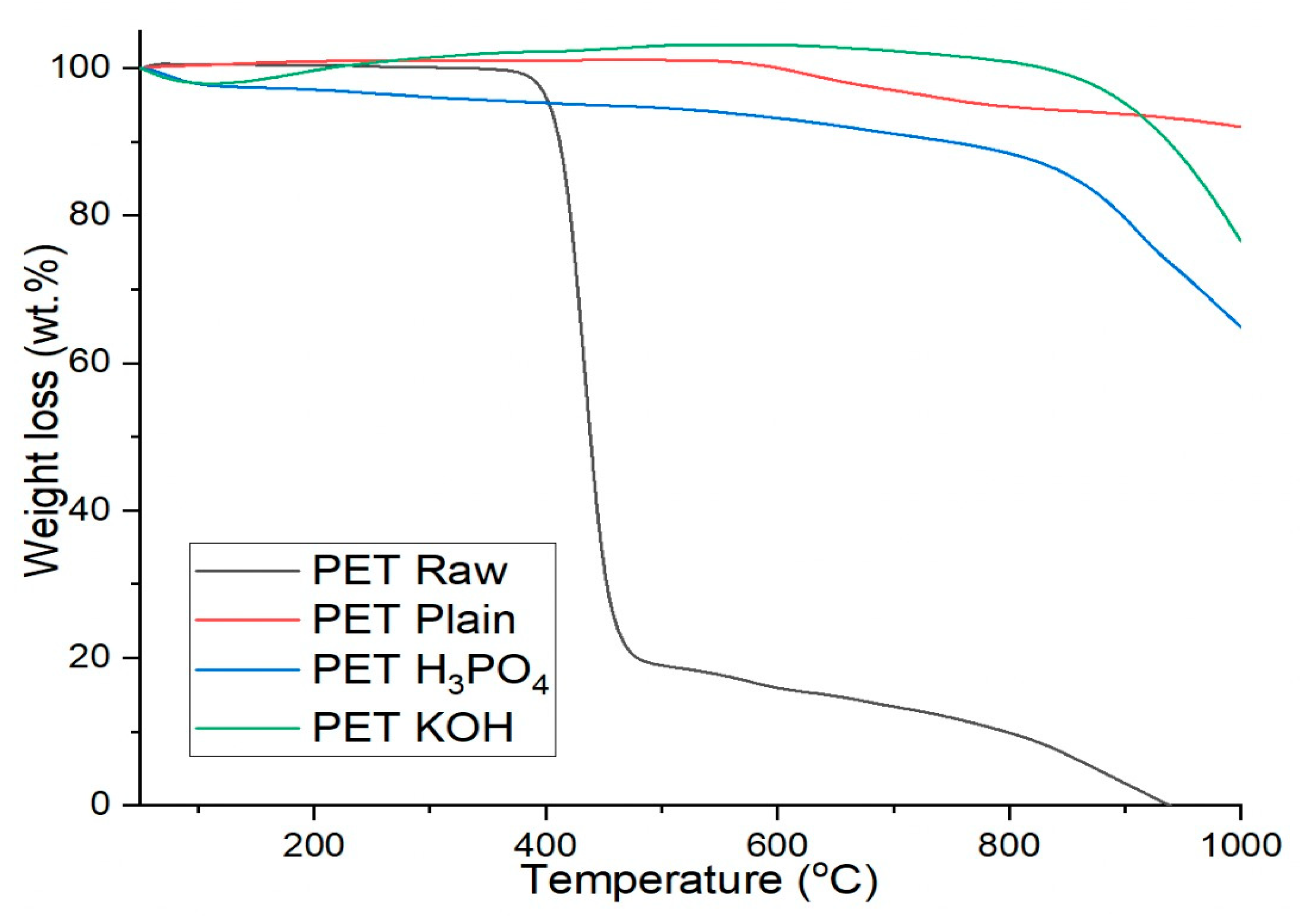Conversion of Waste Polyethylene Terephthalate (PET) Polymer into Activated Carbon and Its Feasibility to Produce Green Fuel
Abstract
1. Introduction
2. Materials and Methods
2.1. Materials
2.2. Synthesis of Activated Carbon from Waste PET Bottles
2.3. Characterization of Activated Char
2.4. Application of Biodiesel Conversion
3. Results and Discussion
3.1. Field Emission Scanning Electron Microscopy (FESEM) Evaluation
3.2. N2 Adsorption and Desorption Evaluation
3.3. Temperature-Programmed Desorption of Carbon Dioxide and Ammonia (TPD-CO2/NH3)
3.4. Material’s Thermal Stability Analysis Using Thermogravimetric Analysis (TGA)
3.5. Crystallinity Evaluation via XRD Analysis
3.6. Functional Groups Evaluation via FTIR
3.7. Application of PET H3PO4 and PET KOH for Green Fuel Production
4. Conclusions
Author Contributions
Funding
Institutional Review Board Statement
Informed Consent Statement
Data Availability Statement
Acknowledgments
Conflicts of Interest
References
- Belo, C.R.; da Paixão Cansado, I.P.; Mourão, P.A.M. Synthetic polymers blend used in the production of high activated carbon for pesticides removals from liquid phase. Environ. Technol. 2017, 38, 285–296. [Google Scholar] [CrossRef] [PubMed]
- Esfandiari, A.; Kaghazchi, T.; Soleimani, M. Preparation and evaluation of activated carbons obtained by physical activation of polyethyleneterephthalate (PET) wastes. J. Taiwan Inst. Chem. Eng. 2012, 43, 631–637. [Google Scholar] [CrossRef]
- Almazán-Almazán, M.C.; Pérez-Mendoza, M.; Domingo-García, M.; Fernández-Morales, I.; López, F.J.; López-Garzón, F.J. The influence of the process conditions on the characteristics of activated carbons obtained from PET de-polymerisation. Fuel Process. Technol. 2010, 91, 236–242. [Google Scholar] [CrossRef]
- Miandad, R.; Barakat, M.A.; Aburiazaiza, A.S.; Rehan, M.; Nizami, A.S. Catalytic pyrolysis of plastic waste: A review. Process. Saf. Environ. Prot. 2016, 102, 822–838. [Google Scholar] [CrossRef]
- Diaz-Silvarrey, L.S.; McMahon, A.; Phan, A.N. Benzoic acid recovery via waste poly(ethylene terephthalate) (PET) catalytic pyrolysis using sulphated zirconia catalyst. J. Anal. Appl. Pyrolysis 2018, 134, 621–631. [Google Scholar] [CrossRef]
- Sardon, H.; Dove, A.P. Plastics recycling with a difference. Science 2018, 360, 380–381. [Google Scholar] [CrossRef] [PubMed]
- Malaysians Asia’s Biggest Plastic Consumers. Available online: https://www.nst.com.my/news/nation/2020/02/566374/report-malaysians-asias-biggest-plastic-consumers (accessed on 6 October 2021).
- Ahmad, J.; Patuzzi, F.; Rashid, U.; Shahabz, M.; Ngamcharussrivichai, C.; Baratieri, M. Exploring untapped effect of process conditions on biochar characteristics and applications. Environ. Technol. Innov. 2021, 21, 101310. [Google Scholar] [CrossRef]
- Ahmad, J.; Cordioli, E.; Patuzzi, F.; Prando, D.; Castaldi, M.J.; Baratieri, M. Possible utilization pathways of char from biomass thermochemical conversion: Char as a catalytic filtering medium for tar cracking. In Proceedings of the 24th European Biomass Conference and Exhibition, Amsterdam, The Netherlands, 6–9 June 2016; pp. 475–479. [Google Scholar]
- Mourão, P.A.M.; Cansado, I.P.P.; Carrott, P.J.M.; Ribeiro Carrott, M.M.L. Designing activated carbons from natural and synthetic raw materials for pollutants adsorption. Mater. Sci. Forum 2010, 636, 1404–1409. [Google Scholar] [CrossRef]
- da Paixão Cansado, I.P.; Belo, C.R.; Mourão, P.A.M. Pesticides abatement using activated carbon produced from a mixture of synthetic polymers by chemical activation with KOH and K2CO3. Environ. Nanotechnol. Monit. Manag. 2019, 12, 100261. [Google Scholar] [CrossRef][Green Version]
- Singh, E.; Kumar, A.; Khapre, A.; Saikia, P.; Shukla, S.K.; Kumar, S. Efficient removal of arsenic using plastic waste char: Prevailing mechanism and sorption performance. J. Water Process. Eng. 2020, 33, 101095. [Google Scholar] [CrossRef]
- Akinfalabi, S.I.; Rashid, U.; Yunus, R.; Taufiq-Yap, Y.H. Appraisal of sulphonation processes to synthesize palm waste biochar catalysts for the esterification of palm fatty acid distillate. Catalysts 2019, 9, 184. [Google Scholar] [CrossRef]
- Liu, L.; Li, Y.; Fan, S. Preparation of KOH and H3PO4 modified biochar and its application in methylene blue removal from aqueous solution. Processes 2019, 7, 891. [Google Scholar] [CrossRef]
- Malins, K.; Kampars, V.; Brinks, J.; Neibolte, I.; Murnieks, R. Synthesis of activated carbon based heterogenous acid catalyst for biodiesel preparation. Appl. Catal. B Environ. 2015, 176, 553–558. [Google Scholar] [CrossRef]
- Ahmad, J.; Rashid, U.; Patuzzi, F.; Baratieri, M.; Taufiq-Yap, Y.H. Synthesis of char-based acidic catalyst for methanolysis of waste cooking oil: An insight into a possible valorization pathway for the solid by-product of gasification. Energy Convers. Manag. 2018, 158, 186–192. [Google Scholar] [CrossRef]
- Ahmad, J.; Vakalis, S.; Patuzzi, F.; Baratieri, M. Effect of process conditions on the surface properties of biomass chars produced by means of pyrolysis and CO2 gasification. Energy Environ. 2020. [Google Scholar] [CrossRef]
- Mateo, W.; Lei, H.; Villota, E.; Qian, M.; Zhao, Y.; Huo, E.; Zhang, Q.; Lin, X.; Wang, C.; Huang, Z. Synthesis and characterization of sulfonated activated carbon as a catalyst for bio-jet fuel production from biomass and waste plastics. Bioresour. Technol. 2020, 297, 122411. [Google Scholar] [CrossRef] [PubMed]
- Zhang, D.; Lin, X.; Zhang, Q.; Ren, X.; Yu, W.; Cai, H. Catalytic pyrolysis of wood-plastic composite waste over activated carbon catalyst for aromatics production: Effect of preparation process of activated carbon. Energy 2020, 212, 118983. [Google Scholar] [CrossRef]
- Li, S.; Huang, S.; Xu, F.; Xiao, H.; Zhang, F.; Zhang, G. Preparing polyester/carbon multifunctional fabrics by phosphoric acid carbonization. Cellulose 2019, 26, 8907–8917. [Google Scholar] [CrossRef]
- Ioakeimidis, C.; Fotopoulou, K.N.; Karapanagioti, H.K.; Geraga, M.; Zeri, C.; Papathanassiou, E.; Galgani, F.; Papatheodorou, G. The degradation potential of PET bottles in the marine environment: An ATR-FTIR based approach. Sci. Rep. 2016, 6, 23501. [Google Scholar] [CrossRef] [PubMed]
- Jin, Q.; Wang, X.; Li, S.; Mikulčić, H.; Bešenić, T.; Deng, S.; Vujanović, M.; Tan, H.; Kumfer, B.M. Synergistic effects during co-pyrolysis of biomass and plastic: Gas, tar, soot, char products and thermogravimetric study. J. Energy Inst. 2019, 92, 108–117. [Google Scholar] [CrossRef]






| Materials | SBET (m2 g−1) * | Dp (nm) ** | Vp (cm3 g−1) *** | TPD-CO2 | TPD-NH3 | Conversion (%) |
|---|---|---|---|---|---|---|
| Total Basicity (mmol g−1) | Total Acidity (mmol g−1) | |||||
| PET Raw | 24 | 5.02 | 0.06 | ND | ND | ND |
| PET Plain | 66 | 5.32 | 0.10 | 1.69 | 3.99 | ND |
| PET H3PO4 | 261 | 4.71 | 0.15 | 0.17 | 18.17 | 45 |
| PET KOH | 141 | 5.92 | 0.24 | 13.49 | 3.50 | 50 |
Publisher’s Note: MDPI stays neutral with regard to jurisdictional claims in published maps and institutional affiliations. |
© 2021 by the authors. Licensee MDPI, Basel, Switzerland. This article is an open access article distributed under the terms and conditions of the Creative Commons Attribution (CC BY) license (https://creativecommons.org/licenses/by/4.0/).
Share and Cite
Ahangar, F.A.; Rashid, U.; Ahmad, J.; Tsubota, T.; Alsalme, A. Conversion of Waste Polyethylene Terephthalate (PET) Polymer into Activated Carbon and Its Feasibility to Produce Green Fuel. Polymers 2021, 13, 3952. https://doi.org/10.3390/polym13223952
Ahangar FA, Rashid U, Ahmad J, Tsubota T, Alsalme A. Conversion of Waste Polyethylene Terephthalate (PET) Polymer into Activated Carbon and Its Feasibility to Produce Green Fuel. Polymers. 2021; 13(22):3952. https://doi.org/10.3390/polym13223952
Chicago/Turabian StyleAhangar, Firdous Ahmad, Umer Rashid, Junaid Ahmad, Toshiki Tsubota, and Ali Alsalme. 2021. "Conversion of Waste Polyethylene Terephthalate (PET) Polymer into Activated Carbon and Its Feasibility to Produce Green Fuel" Polymers 13, no. 22: 3952. https://doi.org/10.3390/polym13223952
APA StyleAhangar, F. A., Rashid, U., Ahmad, J., Tsubota, T., & Alsalme, A. (2021). Conversion of Waste Polyethylene Terephthalate (PET) Polymer into Activated Carbon and Its Feasibility to Produce Green Fuel. Polymers, 13(22), 3952. https://doi.org/10.3390/polym13223952









